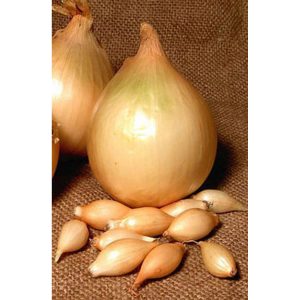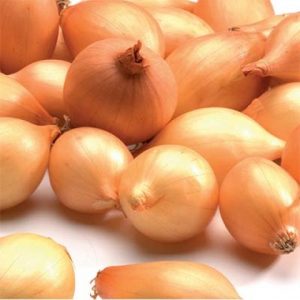An early ripe onion variety "Alpha", which is well stored
Alpha is one of the most popular early ripening onions. Bred in England, it quickly attracted the attention of gardeners in many countries due to its high yield and resistance to diseases. Vegetables ripen quickly and have a long shelf life.
The article will tell you about the peculiarities of growing the variety and the conditions for obtaining a rich harvest.
The content of the article
Description of the variety
Alpha is an early crop: the crop ripens in just 40-60 days.
Attention! Small-sized vegetable, one- and two-pronged: 1-2 bulbs form in 1 nest from 1 set.
Alpha was bred by English breeders, originator - Allium Seeds Uk Ltd. The variety was included in the State Register of Russia in 2014.
Composition and useful properties
Nutritional value of a vegetable (per 100 g):
- proteins - 1.4 g;

- fats - 0.2 g;
- carbohydrates - 8.2 g;
- calorie content - 41 kcal;
- water - 86 g;
- dietary fiber - 3 g.
Vitamin composition of onions:
| Vitamins | Content per 100 g |
| IN 1 | 0.05 mg |
| AT 2 | 0.02 mg |
| AT 4 | 6.1 mg |
| AT 5 | 0.1 mg |
| AT 6 | 0.12 mg |
| AT 9 | 9 μg |
| C | 10 mg |
| E | 0.2 mg |
| H | 0.9 μg |
| TO | 0.4 μg |
| RR | 0.5 mg |
Main macro- and microelements:
| Name | Content per 100 g |
| Potassium | 175 mg |
| Calcium | 31 mg |
| Magnesium | 14 mg |
| Sodium | 4 mg |
| Phosphorus | 58 mg |
| Chlorine | 25 mg |
| Silicon | 5 mg |
| Iron | 0.8 mg |
| Manganese | 0.23 mg |
| Copper | 85 mcg |
| Zinc | 0.85 mg |
| Cobalt | 5 μg |
Phytoncides in the vegetable have a detrimental effect on tuberculosis and dysentery sticks, destroy other pathogens. Onion has tonic, expectorant, antiseptic properties, strengthens the immune system, lowers blood pressure, improves blood composition, and activates metabolism.
Ripening period
It takes no more than 2 months for Alpha onions to ripen when performing standard agricultural techniques. On average, the crop is harvested after 50 days.
Disease resistance
The variety has a strong immunity to the main diseases of the crop, and is rarely attacked by pests. However, frequent watering, violation of the rules of crop rotation reduces the stability of the onion.
Specifications
Ripe bulbs have a rounded shape, a thin neck, golden-yellow dry scales, which eventually acquire a brownish tint. The pulp is white or yellowish. The taste is spicy. Vegetable weight - 90-120 g.
The marketable yield is high, 176–236 kg / ha. The maximum result (393 c / ha) was obtained in the Belgorod region.
For which regions is it suitable
Alpha is recommended for the Central Black Earth region, but due to its frost resistance it is suitable for areas with a temperate climate.
Main advantages and disadvantages
Variety advantages:
- high productivity;
- the duration of storage of vegetables;
- immunity to diseases and pests;
- frost resistance;
- early ripening.
Disadvantages:
- exactingness to the ground;
- the need for regular feeding.
Unlike other varieties, Alpha ripens early, is resistant to various diseases with proper care, and gives consistently high yields.
Features of planting and growing
Although the cultivation of this variety is largely standard, it is important to observe some nuances.
Preparing for landing
For sowing, use only last year's nigella, otherwise the germination rate will be low. Seedspurchased from the store do not need additional processing.
The site is chosen flat, well lit. The soil is pre-dug, treated with herbicides, and grooves are made.
Important! Onions are not planted in lowlands: having absorbed excess moisture, it will significantly reduce keeping rates.
Ground requirements
Alpha is more demanding on soil composition than most varieties. Prefers slightly alkaline soil. Too acidic earth is alkalized. Dolomite flour is used for liming. If the soil is depleted, organic fertilizers are applied in the fall (10 kg / m2).
Timing, scheme and landing rules

In spring, onions are planted in the first or last days of May, when the soil warms up to + 10 ° C. The scheme is standard: row spacing - 30 cm each, width between plants - 5-10 cm, planting depth - 3-5 cm.
Before winter, the culture is planted in mid-October according to a similar scheme.
Attention! Onions planted in late autumn, before the onset of frost, do not start up arrows and are stored for a long time. In spring sowing, the yield will be higher.
Growing features
For onions to develop properly, the soil must contain nitrogen. If it has not been fertilized since autumn, then in the spring, before sowing, add 30 ml of ammonia to a bucket of water, mix thoroughly and water the soil.
After planting, the beds are mulched and covered with foil for better seed germination. When sprouts appear, the shelter is removed, the soil is sprinkled with sand to preserve heat.
The nuances of care
Onion cultivation is standard: the beds are regularly watered, fertilized, weeded and loosened.
Watering mode
Alpha needs abundant moisture during the growing season: 1-2 buckets of water at room temperature are poured onto each bed. Do this once every 2 days. In rainy weather, do not water the onions, otherwise the bulbs will rot. Irrigation is stopped before harvesting.
Loosening and weeding
To prevent the formation of an earth crust and provide access to oxygen, the soil is loosened every 2 weeks after germination. Together with loosening, weeding is carried out, since weeds grow faster than onions and take away nutrients from it.
Top dressing
2 weeks after the first shoots, the culture is fertilized with a mixture of minerals (40 superphosphate, 30 g of ammonium nitrate, 20 g of potassium chloride per 10 l of water). For each 1 m2 spend 1-2 liters of funds.
Summer residents often use herbal infusion: about 1 kg of cut grass is poured with a bucket of water, infused for a week, diluted in half, add 1 tbsp. wood ash.
As an organic feeding, a solution of chicken manure (1:20) is used, which is infused for 10-14 days. After that, it is again diluted with water 15–20 times and the onion is poured under the root.
Disease and pest control

If the rules of care are not followed, the onion is exposed to diseases and attacks of pests:
- Onion flies... Insects are scared off by the smells of carrots, tomatoes, parsley. Planting is sprayed with infusions of tobacco dust, wormwood, lemon balm. As a preventive measure, after harvesting, the soil is carefully dug up, and before sowing it is treated with saline.
- Lurkers. The leaves damaged by the beetle are removed. A mixture of tobacco dust and ash (1: 2) is scattered between the rows. For prevention, they observe the rules of crop rotation, destroy plant residues, dig deep into the earth.
- Thrips. Insecticides are used against them, sticky traps are placed between the beds. The row spacings are periodically weeded, for the winter the soil is treated with "Karbofos" (0.15%).
The main illness:
- Peronosporosis. For treatment, seedlings are treated with "Oxyhom", for prevention, the seedlings are warmed up before planting.
- Fusarium. To fight the disease, use "HOM". The planting material is treated with fungicides.
- Gray rot. Limit the introduction of nitrogen fertilizers and increase the dose of phosphorus-potassium.
Harvesting and storage
Ripe onions are identified by the yellowed feathers that lie on the ground and the characteristic color of dry scales.
How and when to collect
The crop is harvested in dry, clear weather before the onset of the first frost, around the end of September or mid-October. The bulbs are placed neatly, dried in the sun. If the vegetables were planted before winter, then they are dug up at the end of spring.
Storage features and keeping quality of the variety
Store the crop in a dark place with sufficient air circulation, low humidity and a temperature of at least + 10 ° C.
Important! Thoroughly dried onions are placed in nets or baskets. In plastic bags, oxygen will not flow to the vegetables, which will lead to rotting of the fruit.
If the harvest has been thoroughly dried, a suitable storage place has been chosen, then the onion will not lose its presentation and taste for 6-9 months.
Growing difficulties
The main problems that vegetable growers face when cultivating Alpha onions:
- yellowing of leaves due to prolonged rains, prolonged drought, temperature changes;
- rotting vegetables with excessive moisture or planting infected seeds;
- change in the color of feathers with a lack of nutrients.
Tips from experienced gardeners
Farmers' recommendations for obtaining a quality crop:
- all formed arrows break off at the root;
- at the very beginning of the growing season, the onions are watered abundantly, gradually the amount of water is reduced;
- harvest before heavy rains so that it is well preserved.
Reviews
Basically, farmers speak positively about the variety, note its yield, early maturity.
Svetlana, Omsk: “After living in the city for many years, my husband and I moved to the countryside. First of all, on my site, I planted onions, but the first experiment failed. I read rave reviews about the Alpha variety and its description. The bow really made me happy. It grows just fine, gives a rich harvest every year. Recommend!"
Raisa, Barnaul: “Since childhood I have been accustomed to working in the garden. I have a small garden plot where I mainly grow greens. I do not make any special efforts when growing, and I do not need large care costs. Even our children are eager to eat fresh onions ”.
Ekaterina, Moscow: “A neighbor advised the Alpha bow, and I decided to try planting it at my place. I didn't expect a big harvest, but in vain: vegetables grow quickly and are large in size. Now I am planting only this variety. "
Conclusion
The Alpha onion variety appeared in Russia not so long ago, but has already become popular among gardeners. The harvest is stored for 6-9 months, and planting a vegetable does not require much time and effort. The culture is frost-resistant, ripens quickly and pleases with a rich harvest of pungent bulbs.